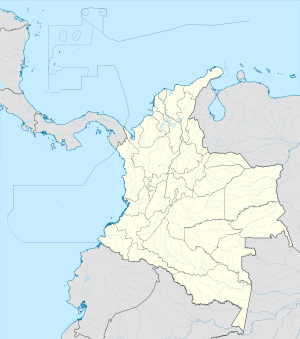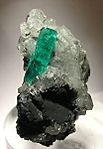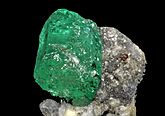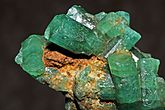Muzo facts for kids
Quick facts for kids
Muzo
Villa de la Santísima Trinidad de los Muzos
|
||
|---|---|---|
|
Municipality and town
|
||
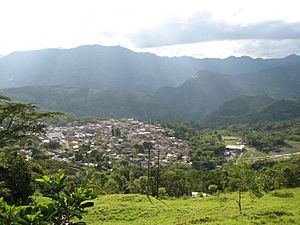
View of Muzo
|
||
|
||
| Etymology: Muzo | ||
| Nickname(s):
Emerald capital of the world
|
||
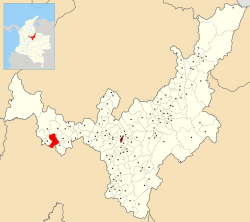
Location of the municipality and town of Muzo in the Boyacá Department of Colombia
|
||
| Country | ||
| Department | Boyacá Department | |
| Province | Western Boyacá Province | |
| Founded | 20 February 1559 | |
| Founded by | Luis Lanchero | |
| Area | ||
| • Municipality and town | 147 km2 (57 sq mi) | |
| Elevation | 815 m (2,674 ft) | |
| Population
(2015)
|
||
| • Municipality and town | 9,040 | |
| • Density | 61.50/km2 (159.3/sq mi) | |
| • Urban | 5,350 | |
| Time zone | UTC-5 (Colombia Standard Time) | |
Muzo is a town and municipality in the Boyacá department of Colombia. It is famous around the world as the "Emerald capital of the world". This is because its mines produce some of the highest quality emeralds found anywhere.
Muzo is located about 178 kilometers (110 miles) from Tunja, the capital city of Boyacá. The town center sits at an elevation of 815 meters (2,674 feet) above sea level. Muzo shares borders with several other towns and the Cundinamarca department.
Contents
What's in a Name?
The town of Muzo was first called Villa de la Santísima Trinidad de los Muzos by the Spanish. This long name was often shortened to just Trinidad.
The name "Muzo" comes from the Muzo people, who were the original inhabitants of this area. They lived here long before the Spanish arrived.
Weather in Muzo
Muzo has a warm climate. The average temperature is about 26 degrees Celsius (79 degrees Fahrenheit). It also gets a lot of rain, with about 3,152 millimeters (124 inches) of rain each year.
A Look Back: Muzo's History
Before the Spanish arrived, the Muzo region was home to the Muzo people. They were known as "The Emerald People" because they mined these precious green gems. They used simple tools like hard wooden poles and water to carefully remove the emeralds from the rock formations. Historians believe the Muzo people settled in this area around 1000 AD.
The Muzo people spoke a language called Cariban. Like their neighbors, the Muisca, they honored the Sun and Moon as gods. However, unlike the Muisca, the Muzo did not build large temples.
Spanish Arrival and Conquest
The Spanish were very interested in finding valuable resources in Colombia. After conquering the Muisca people, they sent explorers into the Muzo lands.
The first Spanish explorer to reach Muzo territory was Luis Lanchero in 1539. He faced strong resistance from the Muzo people. They used the rough landscape to their advantage and attacked the Spanish soldiers with poisoned arrows. Lanchero had to retreat in 1541.
In 1544, another Spanish explorer, Diego Martínez, found the rich emerald mines of Muzo. This made the Spanish even more determined to control the area.
Several years later, in 1552, Pedro de Ursúa also tried to conquer the Muzo, but he failed. Finally, Luis Lanchero returned to the area in 1559. This time, he defeated the Muzo people. On February 20, 1559, he officially founded the town of Villa de la Santísima Trinidad de los Muzos.
The Colonial Period
After the Spanish took control, they were very interested in the high-quality emeralds from Muzo. They set up special systems called encomiendas to manage the mines. They used the local indigenous people to work in these mines, extracting the valuable gemstones.
Muzo's Economy
The main way people in Muzo make a living is through emerald mining. About 75% of the town's income comes from this activity. The remaining 25% comes from farming and raising animals.
Farmers in Muzo grow crops like sugarcane, cacao (used to make chocolate), yuca, avocados, and citrus fruits.
Famous Emeralds from Muzo
The Muzo mines are located in the western part of the Colombian Andes mountains. These mines have produced some of the world's most famous emeralds.
One example is the Duke of Devonshire Emerald. This is a huge, uncut emerald weighing about 1384 carats (about 277 grams). It was given as a gift to the Duke of Devonshire in 1831 by Emperor Dom Pedro I of Brazil.
In 1916, the US National Museum studied the emerald mines in Muzo.
Gallery
-
Muzo emerald on calcite
5.3 x 3 x 3 cm
See also
 In Spanish: Muzo para niños
In Spanish: Muzo para niños



